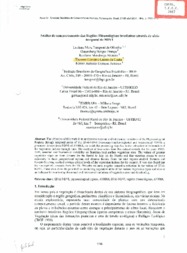Analise de comportamento das regiões fitoecológicas brasileiras através de série temporal de NDVI.
Analise de comportamento das regiões fitoecológicas brasileiras através de série temporal de NDVI.
Author(s): OLIVEIRA, L. M. T. de; FRANÇA, G. B.; NICÁCIO, R. M.; COSTA, T. C. e C. da; ANTUNES, M. A. H.
Summary: The objective of this study is to analyze the seasonal and interannual variations of the Phytoecological Regions through temporal series of the EF AI-NDVI (European Fourier-Adjusted and Interpolated NDVI), a processed dataset from NDVI of A VHRR, on which the processing steps led to the extraction of information of the vegetation indices through time. The analysis of time-series ITom this dataset reveals, for the years 1982-1999, seasonal and interannual variability on Brazilian land surface vegetation state. The values of greatest vegetative vigor go from January (in the South) to July (in the North) and this variation seems to occur repeatedly in those geographical regions and climatic factors. From the nine regions studied, Savanna and Estepic-Savanna, reached average criticallevels of the vegetation indices for the country. It was also found that the stratospheric aerosols ITom the Mt. Pinatubo volcanic eruption caused a reduction in the values of EF AI-NDVI. These data show the potential to monitoring vegetative state of the various vegetation types and also as an indicator for monitoring the annual and interannual variations ofvegetation state and functioning.
Publication year: 2007
Types of publication: Paper in annals and proceedings
Unit: Embrapa Maize & Sorghum
Keywords: A VHRR, EF AI-NDVI, phytoecological regions, regiões fitoecológicas
Observation
Some of Embrapa's publications are published as ePub files. To read them, use or download one of the following free software options to your computer or mobile device. Android: Google Play Books; IOS: iBooks; Windows and Linux: Calibre.
Access other publications
Access the Agricultural Research Database (BDPA) to consult Embrapa's full library collection and records.
Visit Embrapa Bookstore to purchase books and other publications sold by Embrapa.

